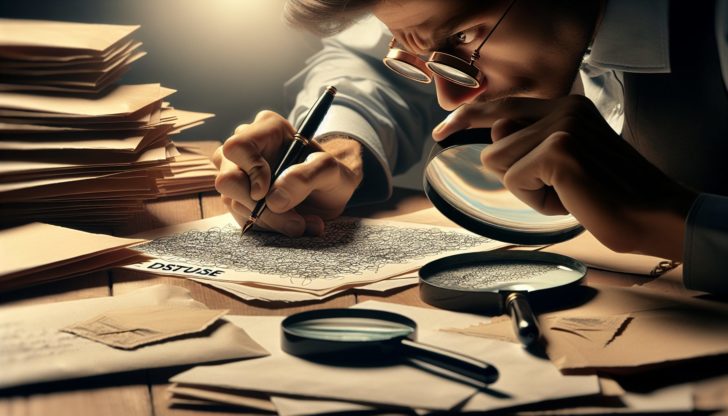Dispute inaccuracies on your credit report effectively with a well-prepared credit dispute letter. This article offers a straightforward guide on crafting your dispute, pinpointing errors, and the evidence needed to make your case. It’s more than fixing mistakes; it’s about protecting and potentially enhancing your credit score. Start with knowing what to include in your letter, where to send it, and understanding the impact it could have on your records.
Table of Contents
Key Takeaways
A credit dispute letter is a formal document challenging inaccuracies on your credit report and must be precisely crafted, containing detailed itemizations and supporting evidence for effective communication with credit bureaus.
Certified mail is the recommended method for sending credit dispute letters as it provides proof of delivery and the receipt serves as verifiable acknowledgment of the bureau’s receipt of the dispute.
Engaging in regular reviews of your credit reports is crucial for early detection of errors, allowing you to dispute inaccuracies before they impact your financial opportunities and credit score.
Decoding the Credit Dispute Letter

Have you ever examined your Experian credit report and discovered an error that made your heart skip a beat? It’s a common plight, but fear not, for the credit dispute letter is your beacon of hope. Consider this a formal declaration, a written challenge to the credit bureaus—Equifax, Experian, and TransUnion—defending against inaccuracies that tarnish your financial image. Whether it’s a mistaken late payment or an account you don’t recognize, this letter is your first step toward setting the record straight with your TransUnion credit report.
The impact of a well-crafted dispute letter is not trivial; it echoes through your credit history, prompting credit bureaus and lenders alike to take notice and act. Its essence is to correct errors on your credit reports and ensure any affected parties are duly informed—a process underpinned by the Fair Credit Reporting Act (FCRA). The success of this endeavor, however, hinges on the strength of your argument and the clarity of the evidence you present.
Crafting Your Dispute: Essential Elements

Embarking on the quest to rectify your credit report requires more than just a persuasive narrative; it demands precision and attention to detail. To write a credit dispute, the credit dispute letters you craft should not only convey your concerns but do so with such accuracy that the credit bureaus are compelled to investigate and resolve. It’s a delicate dance of personal identification, itemization, and evidence, culminating in a formal dispute letter that leaves no room for ambiguity.
Identifying Information
At the heart of your dispute letter lies the key to your financial identity—your full name, date of birth, and current address. This trinity of details anchors your letter, firmly linking you to the credit history in question. But why stop there? To further fortify your identity and avoid any potential mix-ups, you may opt to include your Social Security number and even your driver’s license number—optional, but undoubtedly powerful in ensuring the credit bureaus know exactly who you are.
Let’s not forget the breadcrumbs of your past residences; previous addresses from the last two years serve as vital historical markers, providing a more comprehensive portrait of your credit journey. Think of it as laying down the groundwork that not only strengthens your case but also guards against the specter of identity theft—a modern-day financial phantom.
Itemized Dispute Details
Precision is the soul of the itemized dispute details section. Here, you meticulously dissect your credit report, laying bare each inaccuracy with the scrutiny of a detective. Incorrect account numbers, misstated balances, or erroneous credit limits—each disputed item is listed with its corresponding account number and a detailed account of why it has no place on your credit report. This is your chance to shine a spotlight on each oversight, leaving no error unchallenged, no discrepancy unaddressed.
This thorough approach not only presents a clear case to the three major credit bureaus but also weaves a narrative of your financial vigilance. It’s a testament to your proactive stance in maintaining the sanctity of your credit history—a history that should reflect nothing but the truth of your financial conduct, as recorded by the credit reporting company.
Supporting Evidence
Equipped with your dispute details, you now enter the realm of supporting evidence—the bastion of your claim. Here, the abstract becomes concrete with documents that speak volumes: billing statements, payoff statements, and even a copy of your credit report, each annotated with precision to highlight the errors in question. This arsenal of evidence serves a singular purpose: to bolster your case in the eyes of the credit bureaus and facilitate a swift and just investigation.
But why stop at the financials? For a full-frontal assault on inaccuracies, include copies of your government-issued ID and a utility bill, bank statement, or insurance statement for address verification. These documents serve as the foundation, the unshakeable proof of your identity and the veracity of your claims, paving the way for indisputable corrections to your credit report.
Selecting the Right Address: Where to Send Your Dispute
Once you’ve carefully prepared your dispute letter with personal information and supporting evidence, it’s crucial to send it to the appropriate address. This is not a time for guesswork; precision is paramount. If the error tarnishes only one credit bureau’s report, address your letter directly to them. However, if the blemish appears across all three major bureaus’ reports, equip yourself with three stamps—you’ll be sending letters to Equifax, Experian, and TransUnion alike.
It’s important to note that not all errors are born within the walls of credit bureaus. Sometimes, the institution that furnished the incorrect information, perhaps a bank or a lender, must also be confronted with your dispute. In such cases, ensure your letter also finds its way to their doorstep, reinforcing your quest for accuracy and fairness across the financial ecosystem.
The Power of Proof: Sending via Certified Mail
When sending out your dispute, opt for the reliability of certified mail. This stalwart ally provides proof of delivery, a tangible trail of your efforts, should your journey lead to the halls of justice. It’s not just about ensuring your letter reaches its destination; it’s about having an indisputable record that it did so.
The beauty of certified mail lies not only in the proof of delivery but also in the tracking and recipient’s signature—the trinity that forms a verifiable acknowledgment of your letter’s arrival. With return receipt requested, it’s a level of assurance that online disputes, for all their speed and convenience, simply cannot match.
Understanding the Dispute Process Timeline
Patience, they say, is a virtue, and this is particularly true when waiting for the wheels of the credit bureaus to turn. Legally, they have 30 days to investigate your dispute, a span that may extend to 45 days in certain cases. It’s during this time that the credit bureaus and the furnishers of your disputed information engage in a dance of verification, the outcome of which holds the potential to reshape your credit history.
The investigation process begins as soon as your dispute is received, triggering the countdown. The conclusion of this process, should it be in your favor, will see your credit report amended, and you’ll be notified in writing of the victory. If the disputed items are validated, they stay; if not, they may well vanish from your report, lifting the shadow they cast upon your credit score.
Check out Timeline of a payment dispute.
Beyond the Letter: Additional Dispute Methods
Although written disputes are impactful, they are not the only method at your disposal. The digital age offers the convenience of online dispute resolution, with the ability to upload supporting documents swiftly. TransUnion, in particular, provides a speedy online platform for this purpose. However, tread carefully; the ease of online disputes often comes at the cost of a lower success rate in rectifying errors.
Do not underestimate the power of a phone call. Each credit bureau stands ready to hear your voice, to listen to your dispute over the wires. It’s an alternative path, one that, much like the online method, offers a different kind of convenience and immediacy.
In the end, whether you choose the pen, the keyboard, or the phone, each path leads to the same destination—credit report accuracy.
Monitoring Outcomes and Next Steps
The process of disputing often leads to a resolution, although it might not always be in your favor. If your efforts do not bear fruit, all is not lost. You can:
Request a statement of the dispute to be included in your credit report
Re-file with fresh evidence at the ready
Raise your voice to the Federal Consumer Financial Protection Bureau—a bastion for the wronged consumer.
Should the credit bureaus deem your dispute frivolous, they must inform you, providing grounds for their refusal to investigate. It’s a fork in the road that may lead you to collect new evidence or, if your dispute is upheld, to watch as the verified inaccuracies continue to dwell on your report. Yet, there’s a silver lining—if no verification is forthcoming, the disputed items might just disappear.
Navigating Complex Disputes: When to Seek Professional Help
Some disputes are so complex they can feel like navigating a labyrinth of legal and financial obstacles, necessitating professional guidance. In such instances, credit repair professionals emerge as your navigators, their expertise honed to correct untimely and inaccurate negative information that tarnishes your credit reports.
Their arsenal is diverse, equipped to verify personal information, contest inaccuracies, and navigate the nuanced waters of credit repair. Such professionals can be invaluable allies, particularly when past financial missteps loom large on your credit report, and the path forward seems clouded in uncertainty.
Protecting Your Credit Score During the Dispute
Filing a dispute is a neutral act and doesn’t affect your credit score simply by submitting it. But the aftermath, the result of your challenge, can sway your score, for better or worse. A successful dispute that corrects significant errors, such as wrongful late payments or inquiries, may well be a boon to your credit score, reflecting the rectified truth of your financial habits.
The weight of these corrections on your credit score cannot be overstated. The more significant the error, the more profound the potential impact on your score. Yet, if the disputed information withstands your challenge, unchanged after the dust of investigation settles, your credit score too will remain steadfast, unaltered by the dispute’s outcome.
Staying Proactive: Regularly Reviewing Your Credit Reports
Maintaining vigilance acts as a safeguard for accuracy, especially when it comes to credit reports. By reviewing your credit reports regularly, you don the armor of preparedness, catching inaccuracies early and shielding your access to financial opportunities. This proactive habit is your right, with annual free copies of your report from each of the three major credit reporting agencies, including one credit reporting agency, at your disposal.
Such regular reviews are not merely a precaution but a necessity. With as many as 20% of people potentially harboring errors on their credit reports, the odds suggest that your vigilance is well warranted. Before making any significant credit applications, take the time to assess your reports, ensuring the stage is set for the best possible financial performance.
Summary
As we draw the curtains on our journey through the intricacies of credit dispute letters, it’s clear that mastering this tool is about more than just correcting errors—it’s about asserting your financial rights and shaping your credit destiny. From the meticulous crafting of your dispute to the strategic delivery and patient monitoring of outcomes, each step is a calculated move on the chessboard of credit reporting. Embrace the challenge, for the pen is mightier than the credit error, and your proactive engagement is the key to a pristine credit report.
Frequently Asked Questions
How does a credit dispute letter help me?
A credit dispute letter helps by allowing you to formally request credit bureaus to correct any errors or outdated information on your credit report, potentially leading to a more accurate reflection of your financial behavior. This could positively impact your credit score.
Can I file a credit dispute online instead of sending a letter?
Yes, you can file a credit dispute online through each credit bureau’s website, but keep in mind that the success rate of online disputes may be lower than sending a detailed dispute letter through certified mail.
What happens if the credit bureau doesn’t resolve my dispute in my favor?
If the credit bureau doesn’t resolve your dispute in your favor, you can request a statement of the dispute to be included in your credit report. You also have the option to re-file the dispute with new evidence or file a complaint with the Federal Consumer Financial Protection Bureau.
Will filing a dispute affect my credit score?
Filing a dispute will not directly affect your credit score. However, if the dispute results in a correction to your credit report, that change may impact your score. If the dispute doesn’t result in any changes, your score will remain the same.
How often should I check my credit report?
It’s advisable to check your credit report at least once a year to identify and correct errors early and ensure its accuracy. Checking through the three major credit bureaus allows you to do this for free.









